PLS unit 1 modules 1-3
1/53
There's no tags or description
Looks like no tags are added yet.
Name | Mastery | Learn | Test | Matching | Spaced |
|---|
No study sessions yet.
54 Terms
"Think globally, act locally" meaning
Patrick Geddes, urges people to consider the health of the entire planet and to take action in their own communities and cities
"All politics is local"
Tip O'Neill (Speaker of the House of Representatives)
refers to serving the nation by first serving the states and each representatives' own district (why? to get reelected), the most important motivations directing voters are rooted in local concerns.
"everybody likes to talk about the importance of local government until local government actually tries to govern" - article by Charles Pierce
Alexis de Tocqueville
French political writer comes to America and sees difference btwn unitary systems in Europe and decentralized administration in US, writes "Democracy in America" which explains America to Europeans and to Americans themselves
Decentralized administration
a transfer to lower-level central government authorities or to other local authorities who are upwardly accountable to the central government, distribution of power to the states
Daniel Elazar
wrote "American Federalism: A View from the States," said US can be divided up into 3 political cultures based on geography
traditionalistic culture
elitist, political culture that views politics and government as the means of maintaining the existing social order, not very much change, states that used to have slavery

individualistic culture
address individual rights to achieve individual goals, a culture in which people believe that their primary responsibility is to themselves
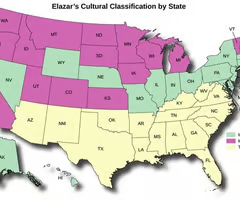
moralistic culture
A political culture that views politics and government as the means to achieve the collective good
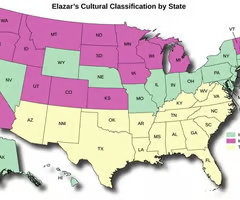
Laboratories of Democracy
louis brandeis (justice), states can try things on a smaller level as an experiment
National Standards
warranted bc they help achieve national goals and keep from dividing the US
10th Amendment
makes clear that any powers that are not specifically given to the federal government, nor withheld from the states, are reserved to those respective states, or to the people at large
Devolution
The process of transferring power and authority to a lower level of government
Dual Federalism
layer cake, political arrangement in which power is divided between the federal and state governments in clearly defined terms, with state governments exercising those powers accorded to them without interference from the federal government, post American Rev
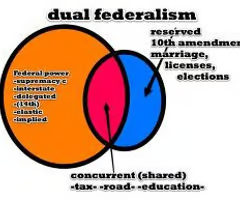
Cooperative Federalism
marble cake, flexible relationship between the federal and state governments in which both work together on a variety of issues and programs, FDR New Deal
Creative Federalism
"picket-fence federalism", Also known as picket fence federalism, creative federalism allows the federal government to decide what the states need, and then provide them with the resources. It shifted power to the federal government, and is evidenced in the Johnson administration's social and welfare reforms in the 1960s, whereby federal funding to states was contingent on adopting a series of federally determined objectives.
New Federalism
cupcakes, In response to the states' loss of power during creative federalism, new federalism included a reassertion of powers going back to the state and local governments in order to create a new balance between the two. One principal vehicle for this shift was to remove the conditionality on federally provided block grants to enable states to choose how to prioritize what they should be spent on, Ronald Reagan
Dillon's Rule
"All power of the local government is derived from the state"
Counties and cities, as administrative subdivisions of the state, assist in the local implementation of state laws and programs
National (Enumerated) Powers under federalism
-regulation of interstate and foreign commerce
-immigration & citizenship
-bankruptcy
-weights & Measures currency
-copyrights & patents
-crimes at sea
-military
-declaration of war
-control of DC
-federal courts
Shared (concurrent) Powers under federalism
-transportation
-taxation
-make & enforce laws
-establish courts
-borrow
-spend money for general welfare
-take private property for public purposes with just compensation
-charter banks & corporations
State (Reserved) Powers under federalism
-education
-police protection
-licensing
-control local gov
-regulate individual & corporate activities in order to protect & enhance public health, welfare, safety, morals, convenience
state constitutions
-represent fundamental law of a state superior to statutory
-A written set of rules that guides how a nation, state, or political organization functions.
-A constitution can determine how much power a government may possess over its citizens and what rights they will have.
-Constitutions can be amended over time to adapt to changing needs, ensuring their relevance.
-The oldest state constitution still in place is Massachusetts, drafted in 1780
State constitution benefits
-Finances: outline how the states tax systems are implemented, debt, property/stock tax
-Civil Liberties: state-specific protections in place that the Federal Constitution does not cover, abortion rights, lgbtq rights
-Courts: Organization of state courts are outlined by the state constitution
State Constitution Limits
CANT:
●Print their own money $$$
●Enter international treaties
●Impose duties on international trade
●Engage in duties reserved for the federal government
●Lower the standard of federal civil liberties
Supremacy Clause
the National Constitution & federal law takes precedence over state law
Ways to Amend a State Constitution
-Constitutional commission: a study commission, it is used to view an existing constitution and recommend changes to the legislature or voters
-Legislative Proposal: Most common, where a revision is approved by a ⅔ majority in the legislature (both houses)
-Initiative: When a proposal is placed on a ballot for voters to choose
-Direct initiative: When voters propose the amendment and bypasses the legislature
-Indirect Initiative: When the proposal must be checked by the legislature before going on the ballot
-Judicial review: The US or State supreme courts can declare acts unconstitutional
Reserved Powers Clause
powers not given to the United States by the Constitution and not prohibited to States, are reserved to the States
Number of Constitutions
●145 total among all states since 1776
○Louisiana has had 11
○The longer and more detailed a constitution the longer it will last (Hammons)
■This is because of better conflict resolution, and more direct guidelines about rules
Number of Amendments
●About 7,000 total amendments to the state constitutions
○Allowing each state to change policies with the needs of their state
How to ratify national amendments
Amendments are ratified through a ⅔ majority in Congress and ¾ of states
How to ratify state amendments
Amendments can be proposed to the Virginia State Senate and a majority vote in the House of Delegates and Virginia Senate will ratify it
Constitution Lengths
National:
-5k words
-Supreme law of the land
-Written in 1787 and ratified in 1788
-8700 words in length
-VII articles, the preamble, and 27 amendments
State:
-longer to address details regarding day-to-day relations between the government and it's people
Shortest - Vermont 8k words
Longest - Alabama 345k words
Purpose of national constitution
●Ensures a checks and balance system between Executive, Legislative, and Judicial
●Emphasizes limiting federal powers while reserving others for the states or the people (Tenth Amendment)
●Government structure consists of a President, a bicameral legislature, and a Supreme Court.
Purpose of state constitution
●Address specific issues relating to state policies, rights, and regulations
●More detailed provisions than the National Constitution
●More focused on local governance
●Government structure consists of a governor, two-house legislative branch, and a state Supreme Court. (Nebraska is one house)
●Represent the fundamental law of a state, superior to statutory law
●Two types of state constitutions exist: Positive-law tradition(based on detailed procedures and provisions) and Higher-law tradition (based on basic principles)
●Specific rules about local governance, civil rights, taxes, education, and social policies
VA State Constitution
VA:
-Created in 1776 with several adjustments since
-Model state constitution was developed in 1921
-21,319 words in length
-Composed of XII articles and a schedule with 54 amendments
-Currently 1971 version
-Revised 6 times
Centralization
Generally, state constitutions follow the federal method of decentralizing power into executive, legislative, and judicial branches. However, states differ in the power or responsibility given to local government. Forty-eight states have separately governed counties, ws, while Connecticut and Rhode Island do not
What makes up federal gov
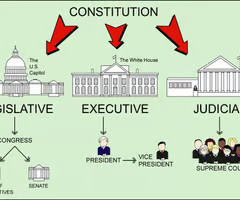
Federal Executive Branch (article II)
President:
●Represents country, commander-in-chief of the military, approves/denies bills, reports to Congress
Federal Legislative Branch (article I)
Congress: organize executive and judicial branches, create laws, declare war
●House of Representatives: (435, varies on state population), power to impeach president, makes/pass federal laws
●Senate: 100 total (2 per state), propose and amend legislation, control of federal budget, approval of presidential nominations, holds trial of impeachment
Federal Judicial Branch (article III)
Supreme Court: (8 justices, 1 chief justice):
●Appointed by president, confirmed by Senate
●Justices serve life terms
●Largely an appeals court
●Determines constitutionality of actions
●Interprets law through judicial review
●Determines which cases will be heard from the lower court levels
State Executive Branch
Governor
Lt Governor
General Assembly
State Legislative Branch
General Assembly:
Senate
House of Delegates
*Nebraska is the only unicameral state, which only has one assembly
What makes up state gov
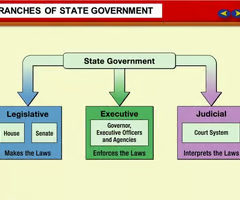
Local Administrative (Executive) Branch
County Manager (administer ordinances)
Local Legislative Branch
Board of Supervisors (makes ordinances)
School Board
Local Judicial Branch
Circuit Court
General District
Juvenile/Domestic Relations
State Judicial Branch
-Each state has a court, which is considered the court of last resort.
-These are State Supreme Courts
Federal Gov Responsibilities
-Uniform law of naturalization
-National Defense
-Regulate Commerce
-Establish federal courts
-House can propose amendments
-Article 1 → gives power to federal government
State Gov Responsibilities
-Infrastructure
-Provide framework for exercising state authority
-Define powers of local government
-10th amendment → any power not given to federal gov't is reserved for the states
Pros of federal gov
●Can create consistent policies across all states
●Has more funding & resources
●Can achieve broader, national goals
●Can protect the security of the entire country
Cons of federal gov
●Slow operating speed, hard to amend legislation
●More pressures from outside sources (alliances, foreign policy, war, etc.)
●Less civic engagement (stricter voting rules, policies don't appeal to everyone, etc.)
pros of state gov
●States can address the specific needs of its citizens
●States can experiment with new policies
●Can reflect diverse cultures and preferences
cons of state gov
●Can not achieve global or widespread goals
●No uniform structure or processes, varies across states
●Smaller budget, works with less money
●Less resources to protect the security of its citizens
Democrats
●Liberalism- progress
●Favors:
○Hand-on government
○Progressive policies
○Civil rights for minorities
○Social welfare programs
○Environmental protection
Republicans
●Conservative- tradition
●Favors:
○Few government regulations
○Less social programs
○Strong national defense
○National security
○Religion and family orientation